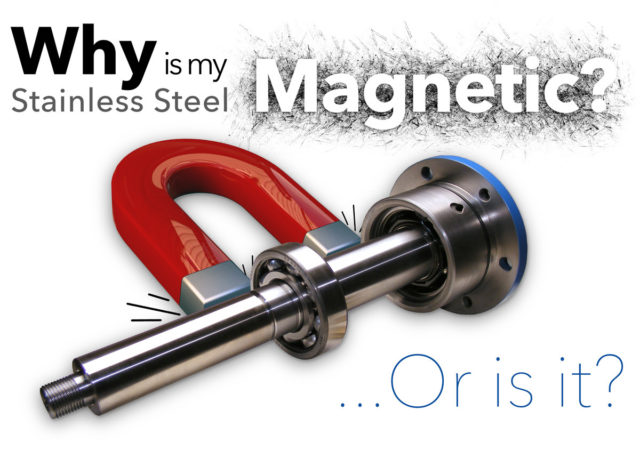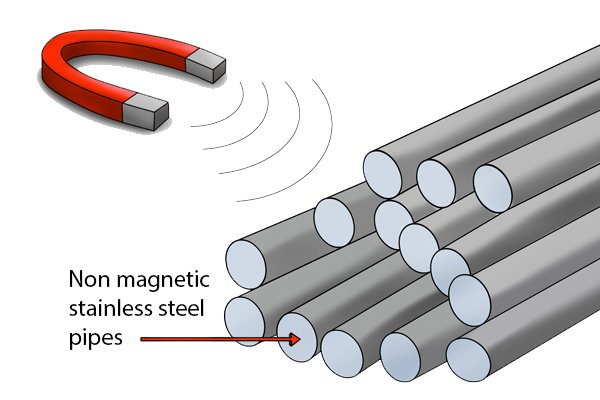Can Stainless Steel Be Attracted to a Magnet
There are many kinds of stainless steel. 188 304 A2 and 410 are more magnetic than 316 or A4 stainless steel.

Why Is My Stainless Steel Magnetic R A Ross Associates
As we know according to the structure under room temperaturestainless steel can be divided into Austenite such as 201 304 321 316 310 Martensite or Ferric such as 430 420 410.

. At Metalwest we commonly stock 201 stainless 301 stainless 304304L stainless and 316316L stainless steel products. It clearly doesnt remove ferromagnetism from steel parts. In fact all of the stainless steel coming into the USA from china and other countries are magnetic in some form.
If you see a label saying something like 301 or 303. The second most common grade is 316 which is used in salt water. A Stainless Steel will only be non-magnetic if it has an Austeneitc crystal structure.
Answer 1 of 2. The most common grade of stainless steel is 304 or as referred to 188 and in metric A2. Ordinary steel is ferrite at room temperature and can be absorbed by magnets.
The Austenetic Crystal structure is Face-Centered Cubic FCC. All FCC steels are non-magnetic even if they are not stainless steels. Yes degaussing can certainly remove magnetism the piece will no longer act as a magnet and attract steel to itself but Im not so sure it does anything to correct a piece of stainless steel that has become ferromagnetic the stainless steel being attracted by a magnet.
Magnetite can absorb iron and nickel. So the next time you are shopping for a refrigerator be sure to bring a magnet. So the best way to determine whether a magnet will stick or not is to try it before you buy it.
Therefore if the plate can be attracted by the magnet it must not be 304. In fact this is a very. The chromium content in grade 409 is 11 which is enough though for use in automotive exhaust systems.
Answer 1 of 5. This stainless steel has very weak magnetic properties. Since austenitic stainless steel alloys are by far the most common you might think that all stainless steel is non-magnetic.
It is known that stainless steels with magnetic properties such as 409 and 430 do not resist corrosion as well as stainless steels with non-magnetic properties such as 304 and 316. Stainless steel appliances are popular because of their durability and they match every wood tone and finish. It is unrealistic to expect them to.
With the right design and strength of Magnetic Separator weakly magnetically susceptible materials such stainless steel can be attracted to the magnet face and captured. Surprisingly a magnet may stick to the side of a refrigerator but not the door. If the product can be attracted by the magnet it must not be demagnetized.
Ordinary consumers have some misunderstandings about stainless steel they think that the magnetic stainless steel is not qualified 304 stainless steel. Or it will cling to a dishwasher but not the refrigerator. For all intents and purposes magnets cant attract austenitic stainless steel.
If a stainless steel product can be absorbed it means that it contains high iron and nickel content. Higher quality and typically more expensive stainless steel appliances will not hold your alphabet magnet set. Even in case of austenitic stainless steel some grades are weakly magnetic and cold worked parts are magnetic.
They think that the stainless steel material is fake and not attracted by the magnet. Why can stainless steel slides be attracted by magnets-Dongguan Lienchiang Furniture Hardware coltd Sliding track Drawer track-After buying a stainless steel slide rail some friends will use a magnet to attract them. At room temperature most ferrous alloys have the.
The most common one is austenitic stainless steel containing chromium and nickel such as 0Cr18Ni9 which contains 18 chromium and 9 nickel. Ferritic stainless steel martensitic stainless steel duplex stainless steel etc. The response of stainless steel to a magnet is an interesting physical property and can be a useful sorting test but it is not as clear-cut as is often thought.
Even non-magnetic stainless steel bolts are found to be very weakly magnetic on the head of the bolt especially if a spanner or socket has been used for tightening and. According to the AISI grade austenitic stainless steel is usually 200 or 300-series. All other steels are attracted to a magnet including all the ferritic duplex martensitic and precipitation hardening stainless steels.
Only austenitic stainless steel is non-magnetic.

Is Stainless Steel Magnetic Fasteners 101 Youtube

Is Stainless Steel Magnetic Youtube

Do Magnets Stick To Stainless Steel Discover What Metals Are Magnetic Why Some Metals Are Not Magnets Com

No comments for "Can Stainless Steel Be Attracted to a Magnet"
Post a Comment